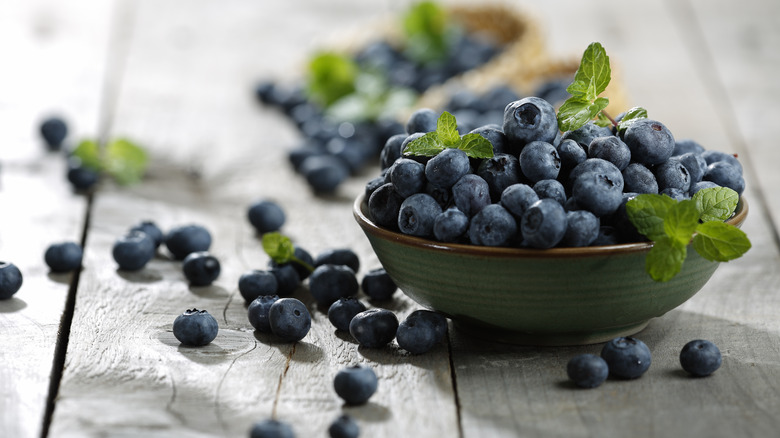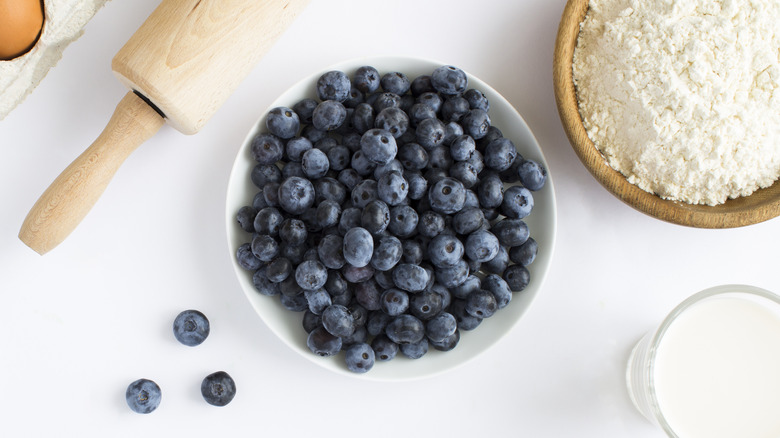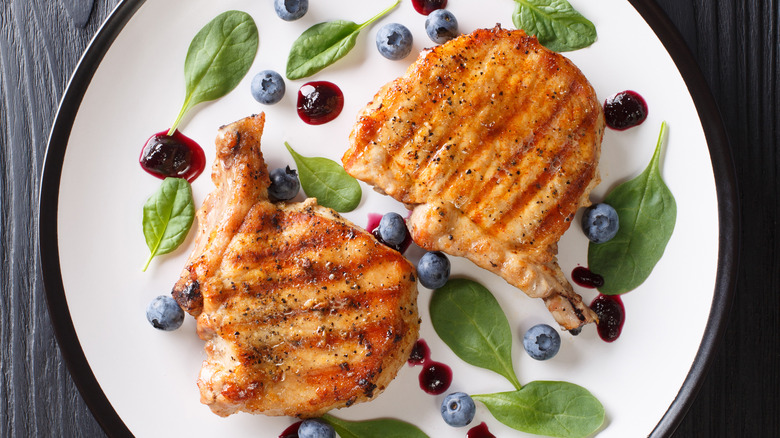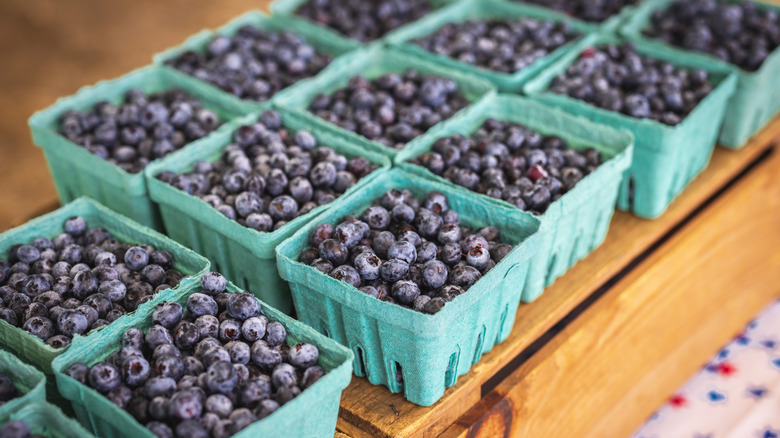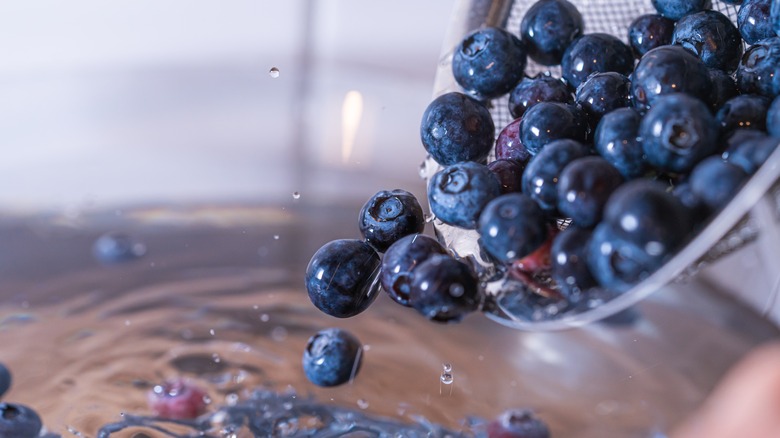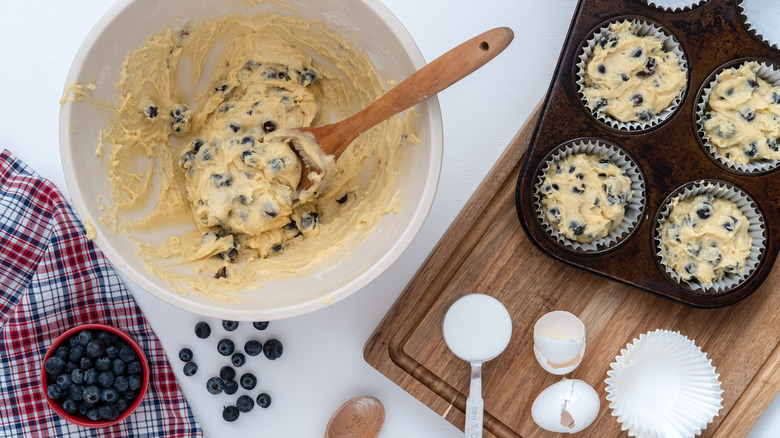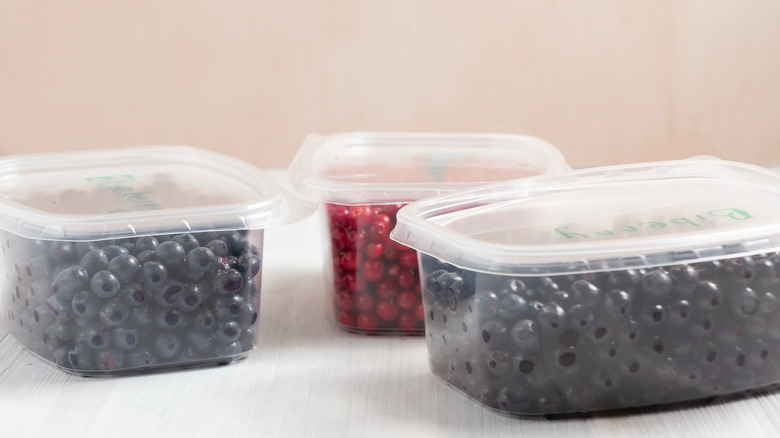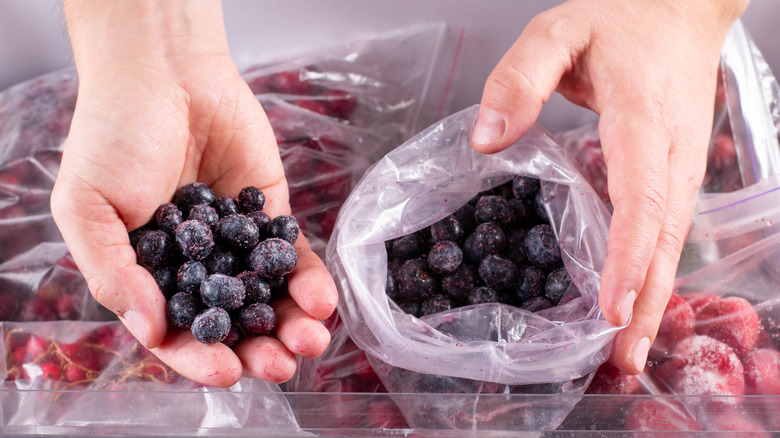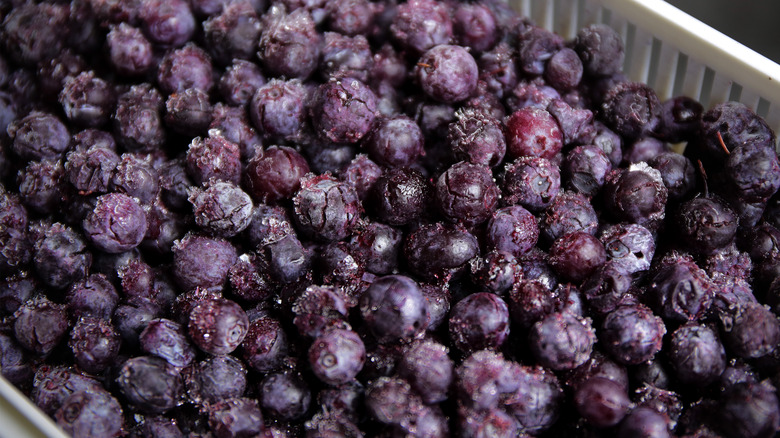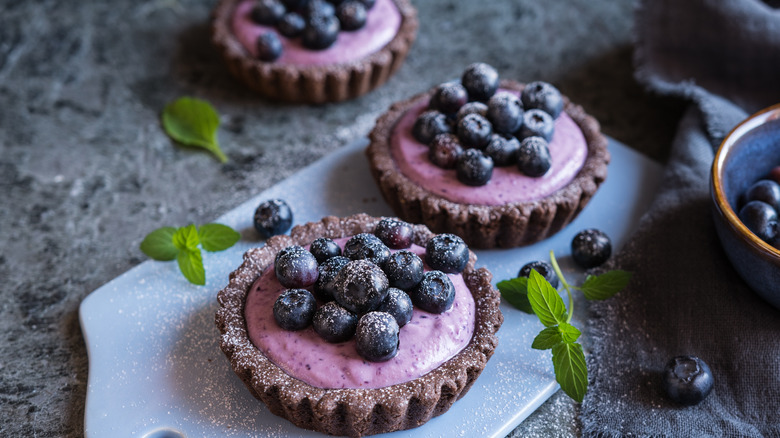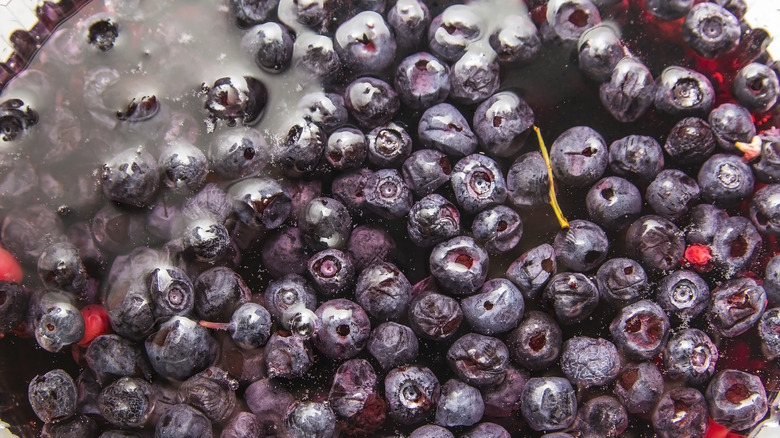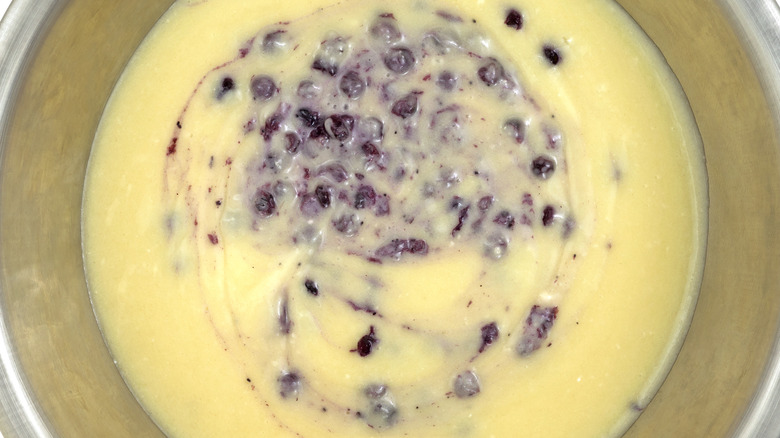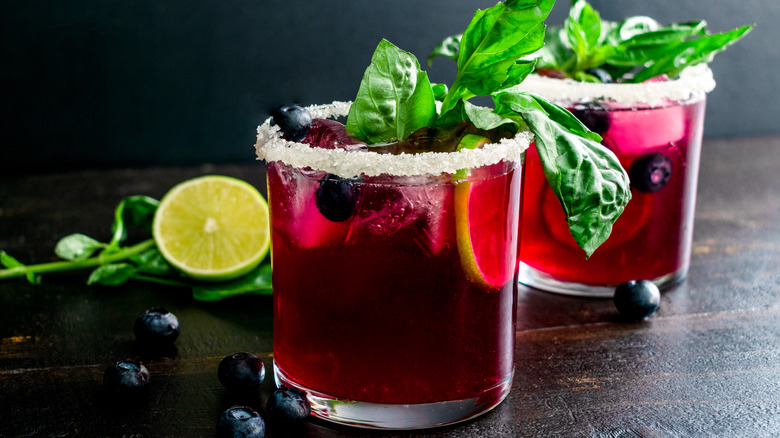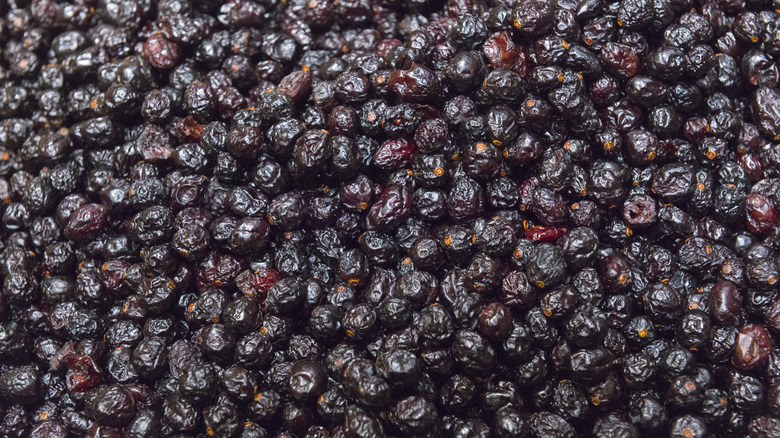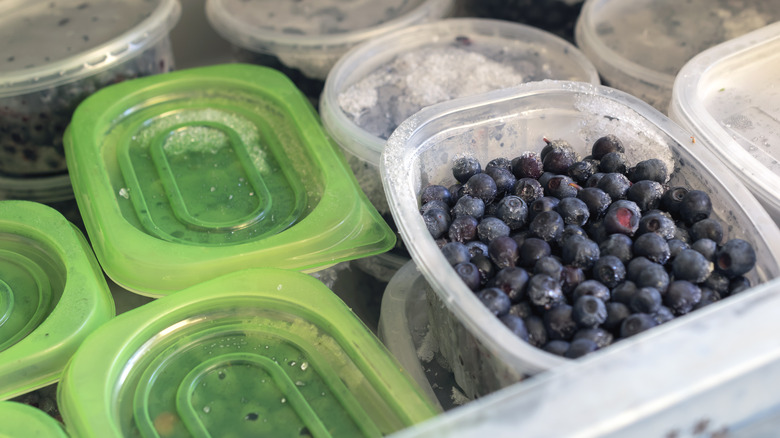14 Mistakes Everyone Makes With Blueberries
Blueberries are the second most consumed berry in the United States behind strawberries (per Statista), and it's easy to see why. The small round berries are bursting with flavor, antioxidants, and hydration, making them the perfect superfood addition to muffins, pancakes, oatmeal, and smoothies. America's love affair with blueberries has grown rapidly over the past generation. According to the U.S.D.A., we only produced about 45,000 tons in the 1990s, but production ramped up to 339,000 by 2019. The country is both the world's top producer of the berry and its top importer (per Tridge), meaning that even though we grow more blueberries than any other country, we still can't keep up with our own demand.
Despite the ubiquity of the berry, there are many ways to maximize its versatility that you might not have thought of. Whether it's proper storage techniques, recipe hacks, or tips for keeping them fresh longer, we've got you covered with a rundown of all the ways you can improve your use of this delicious fruit.
1. Not dredging them in flour before adding them to batter
Blueberry muffins are one of those desserts that just about everyone can get behind. They're sweet, a little tangy, soft, and indulgent. You can even get away with calling them a breakfast food most of the time. For home bakers, however, these muffins can pose challenges. Your blueberries might burst while baking, turn the batter purple, or sink to the bottom, leaving you wondering how such a simple-seeming recipe could go so wrong.
Luckily, one simple trick will solve most of your blueberry-baking problems. Large blueberries are often heavy enough to sink through the thick batter to the bottom of the pan, but when you coat them in flour first, the dry starch acts as a kind of glue, preventing them from sinking as they bake.
To make muffins with evenly distributed berries, take a couple of tablespoons of your mixed dry ingredients and add them to the berries. Coat the berries evenly and add them to the batter. Make sure to use flour from the recipe rather than adding an additional amount, which could result in dry muffins.
2. Only using them in sweet recipes
You've probably had blueberries in a wide range of sweet treats and breakfasts, from smoothies and ice cream to cereal and cake. But savory blueberry recipes are not nearly as common, and it's an untapped area of potential that you should not be afraid to explore. An easy place to start is adding fresh blueberries to salads and mixed drinks. A heart-healthy salad made with spinach, walnuts, feta cheese, blueberries, and lemon vinaigrette might end up being your new superfood obsession, while a gin and tonic mixed with a few blueberries and crushed mint leaves is an instant summer upgrade to a tried and true classic.
On the more adventurous side of things, you can simmer fresh, frozen, or dried blueberries with herbs, and drizzle the sauce over fish, pork, or chicken. You can make it sweeter with port or sugar, or more savory with chicken stock or balsamic vinegar. As soon as you start adding blueberries to everything from pizzas and bruschetta to savory tarts, you'll wonder why you ever thought they only belonged in sweet recipes.
3. Ignoring color when choosing them at the store
Choosing blueberries is harder than choosing other fruits at the grocery store. You can tell a banana is ripe by its color. You know strawberries will be juicy and flavorful if they're plump, shiny, and deep red. But blueberries often look the same no matter how ripe they are. You can select a carton of perfectly-round, large berries only to discover when you get home that they're sour or mealy.
The best way to choose the sweetest, juiciest blueberries is to go by color. It might sound obvious, but you want those blueberries to be blue. Green berries are under-ripe, and even the ones with a slight purple or magenta hue have likely been picked too soon. Unlike bananas, which can be green one minute and brown the next, blueberries do not continue to ripen once they've been harvested. As a result, choosing the ones that are clearly ready to eat is the best way to ensure flavor and quality. In addition to a deep blue color, look for a silvery-white sheen. Called the "bloom," this protective layer indicates that the berries were picked at peak ripeness.
4. Washing them with nothing but water
Blueberries are tiny and delicate, which makes them much harder to wash than, say, an apple or a watermelon. You're not going to stand at your sink and wash each berry individually, nor can you scrub them without squishing them. Even running them under the tap can damage their delicate skins. At the same time, blueberries may carry pesticides and bacteria that you definitely do not want in your body, so washing them is essential (via Food Network). This is especially true when you're planning to eat the berries raw, as cooking is one of the best ways to kill bacteria.
The best way to clean them is to put them in a vinegar bath. Vinegar kills bacteria, mold spores, and whatever else might be lurking on your fresh berries, and it won't leave an unappetizing, astringent flavor the way dish soap can. Soak the berries in a 4:1 ratio of water to vinegar for 2 or 3 minutes before rinsing them thoroughly. Before you stow them in the refrigerator, dry them completely by patting them with a paper towel or kitchen cloth. Moisture promotes mold growth, and storing them in dry conditions is essential to extend their freshness.
5. Adding them to batter too early
Most recipes for blueberry muffins instruct you to put the berries last into the batter after you've gently combined the wet and dry ingredients. But this doesn't prevent them from sinking to the bottom of the tin and giving your muffins a sticky base. It might keep the batter from turning purple, but it doesn't change the unsatisfactory distribution of the berries.
One of the best tricks for keeping those berries away from the bottom of the pan is to add them even later than the recipe suggests. Once you've combined the wet and dry ingredients without the blueberries, put one spoonful of batter into each muffin cup. Then add the blueberries to the remainder of the batter and top up the cups. This ensures that the berries have farther to travel to get to the bottom of the pan. By the time the muffins have baked enough to become bready, the berries will only have sunk enough to be evenly distributed.
6. Not prepping them for the fridge
Unless you're planning to eat an entire carton of blueberries at once, prepping them for the fridge is a non-negotiable step to keep them fresh for days rather than hours. Dampness breeds mold, but so do stray mold spores that might already be living on your blueberries when you buy them. For this reason, it's best to soak them in a vinegar bath right when you get home to kill the bacteria. Start by picking out any berries that are already crushed or moldy. Then, soak them in vinegar water to kill any mold spores. Rinse them thoroughly, and dry them completely to avoid the kind of moisture that will facilitate mold.
Once you've washed and dried your berries, you'll need a proper container to store them. If you purchased them in a clamshell carton with plenty of holes for ventilation, you can simply return them to it, after washing it thoroughly and lining it with a paper towel. If you want the berries to last weeks rather than days, however, you should opt for the next level, which is storing them in single layers in an air-tight container, separated by paper towels. This somewhat time-consuming method pays dividends if you have an excess of berries and want to keep them fresh rather than freeze them.
7. Avoiding frozen berries
Frozen fruit gets a bad rap because they can be soggy and mushy when thawed. If you plan to make a summery fruit salad bursting with juicy flavor, frozen fruit will not hold a candle to fresh. But if your goal is to put the berries into muffins or turn them into jam or compote, you should skip the produce section and head straight for the frozen aisle.
Frozen blueberries retain much of their flavor and can easily be incorporated into baking recipes. Studies have shown that they might even be healthier than fresh blueberries. One research team from the University of Chester monitored the nutrient loss of refrigerated and frozen produce (including blueberries) over several days, and found that frozen foods retained more nutrients than refrigerated ones. Similarly, research from South Dakota State University found that anthocyanins, a powerful group of antioxidants found in blueberry skins, are more available to the body in frozen blueberries than in fresh. Added to these health benefits is the fact that frozen berries are often much more affordable than fresh ones. The next time you're on the fence about whether to splurge on fresh or frozen blueberries, go easy on your wallet without compromising flavor or nutrition and get the frozen ones.
8. Substituting frozen for fresh berries without adjusting the recipe
If you do decide to use frozen blueberries, you'll need to make some recipe adjustments before swapping them for fresh berries. If you're going to bake with them, you should avoid thawing as this will only turn your batter purple. Instead, remove them from the freezer just before adding them, and roll them in a couple of tablespoons of your dry ingredients. This will ensure they don't leach color into the batter during baking, or sink to the bottom of the pan.
Because they're frozen, they will bring down the temperature of whatever you're making. If you're baking, you should add about 5 minutes to the prescribed oven time if the recipe calls for fresh berries. If you're making pancakes, an extra minute or two on the skillet will suffice. Frozen berries also tend to have more moisture. If you're making a pie filling, add a tablespoon of starch, such as tapioca flour, to prevent the pie from turning into a purple puddle, or choose a lattice design for the top part of your crust to allow some of the liquid to evaporate during baking.
9. Never using the color to your advantage
If you've ever baked with blueberries, chances are, you've tried hard to prevent them from staining the batter, your hands, your counters, and whatever you happen to be wearing. But this frustratingly tenacious color can be a useful ingredient in its own right. Food coloring is often made with obscure ingredients that some people try to avoid, but when you make it at home with natural ingredients, you can have brightly colored food without the concerns about what might be behind it.
When mixed with batter, icing, and syrup, blueberry juice turns from purple to a soft purple-blue hue, making it the perfect ingredient to add to recipes flavored with lavender. It will not give you a vibrant, deep purple the way an artificial coloring will, but the soft, pastel color it provides is no less striking. You can achieve a bluer color by blending and straining fresh blueberries and adding a little lemon juice, or a more vivid purple by simmering the berries until the juice is more concentrated. Blueberries are an excellent natural food coloring for baking because, unlike ingredients such as beets, turmeric, and spinach, they do not turn the light, sweet flavor you're trying to achieve into something that tastes vegetal or spicy.
10. Tossing out sour or overly-ripe berries
Because blueberries do not ripen after they've been harvested, you might be tempted to toss an entire carton in the trash if you discover they're hard and sour. On the flip side, you might automatically throw out a box that's been sitting in the fridge for a few days that is starting to look shriveled and soft. Both of these impulses are premature. You might not want to eat the berries by themselves, but you can still turn them into something delicious.
Under-ripe blueberries may be too sour on their own, but they still carry the telltale flavor of blueberries, and like cranberries, they can easily be made palatable with a little sugar. Whether you simmer them with sugar to make jam, add them to a sweet smoothie, or use them for extra tart blueberry muffins, their poorly-timed harvest does not rob them of their potential.
Overripe berries are just as versatile. Steer clear of baking with them, as their softness will make them fall apart in batters and stain everything purple. Freezing them is the first port of call to prevent the aging process. You'll then have them on hand for smoothies, jam, and syrup anytime you need them. Just make sure there isn't any mold on them.
11. Accidentally turning the batter blue
You might be resigned to the greenish-purple hue that spreads into the batter whenever you bake with blueberries. You might even like it for aesthetic reasons. But if you want your pancakes to be golden and your muffins to look like they belong in a bakery window, do not despair, because there are ways to limit the damage. Dredging fresh berries in flour is a good place to start. The protective coating prevents the juice from seeping into the batter while you're stirring or baking it, leaving minimal discoloration.
Frozen berries pose a different challenge, as they are covered in icy juice that bleeds into the batter the moment you add them. The best approach is to run them under cold water first, waiting until the water runs clear. Dry them with a paper towel, dredge them in flour, and add them to your batter. With just a few extra steps, you'll have golden baked goods studded with perfectly intact blueberries — no green streaks in sight.
12. Playing it safe with flavor combinations
Lemon, almond, and vanilla are flavors you'll frequently find paired with blueberries, but they are not the only options. Blueberries provide a subtle yet complex combination of floral, sweet, and acidic flavors that pair beautifully with many ingredients, and failing to explore the possibilities does this vibrant berry a disservice. The botanical taste of blueberries makes them the perfect fit with fresh, citrusy herbs like basil and thyme, as well as the sharp juniper notes of gin.
For baking, the fruity sweetness of blueberries plays well with spicy ingredients like cardamom and nutmeg, as well as the tropical flavor of coconut. For a more surprising combination, try coriander. It may be best known as the seed that spawns the most polarizing herb, cilantro, but it has a secret kinship with blueberries thanks to the shared flavor compound known as linalool. When paired with blueberries, coriander seeds accentuate the floral, citrusy, herbal linalool flavor of blueberries that you might not have noticed before, and create an intoxicating aroma. If you want to intensify the nutty, woody notes of the coriander, toast the seeds before grinding them to release their aromatic oils.
13. Never using dried blueberries
Dried blueberries are nowhere near as ubiquitous as other dried fruits like raisins and cranberries. They are more expensive, but if you have them on hand or find them on sale, you shouldn't hesitate to add them to your favorite recipes. They occupy a middle ground between the pure sweetness of raisins and the tartness of cranberries, making them an easy fit for scones, granola, cookies, and any other baked goods you love. One of the benefits of using dried blueberries is that they won't leach color into your batter or burst during the baking process. If you struggle with blueberry-colored muffins and scones, dried fruit is an easy fix.
When using dried blueberries, there are a few rules of thumb to follow. Because they are dehydrated, dried blueberries will absorb water from your recipe, and you may want to add extra liquid to prevent dryness. Another option is to soak the blueberries in water or orange juice for 30 minutes to rehydrate them and mitigate liquid absorption from the other ingredients. You should also reduce the measurement as the berries lose most of their volume when dried and will expand when baked.
14. Putting them at the back of the fridge
Blueberries are delicate fruit and must be treated with care in order to last for more than a couple of days. Once you've washed, dried, and stowed them in the proper container, you need to find a safe spot for them in the refrigerator. The worst place to put them is in the back. When foods release humidity into the air of your refrigerator, it turns to condensation on the back wall. As the refrigerator cools, the moisture turns to ice. If you put the blueberries close to the back wall, condensation will drip onto them and make them soggy, or worse, the ice will partially freeze them.
The crisper drawer is often cited as the best place for fruit, but that isn't necessarily the case for blueberries. Fruits like bananas and cantaloupe produce a gas called ethylene as they ripen. In contrast, fruits that stop ripening when they are harvested, such as blueberries and oranges, are highly sensitive to ethylene, and begin to rot if they are exposed to it for too long or at high concentrations. It is therefore best to store blueberries in a well-ventilated part of the refrigerator away from ethylene-producing fruits rather than in a closed drawer without airflow. When in doubt, just plop them front and center in your fridge.
